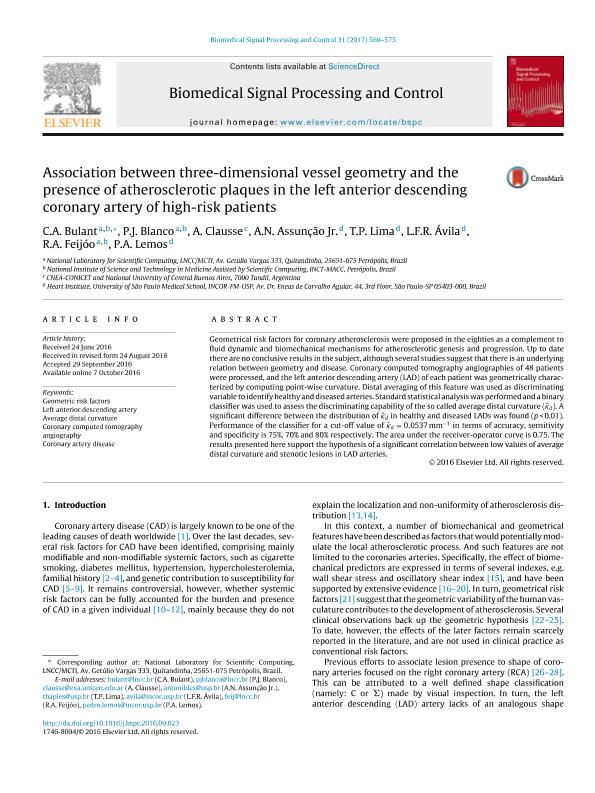Artículo
Association between three-dimensional vessel geometry and the presence of atherosclerotic plaques in the left anterior descending coronary artery of high-risk patients
Bulant, C. A.; Blanco, P. J.; Clausse, Alejandro ; Assunção, A. N.; Lima, T. P.; Ávila, L. F. R.; Feijóo, Raúl Antonino; Lemos, P. A.
; Assunção, A. N.; Lima, T. P.; Ávila, L. F. R.; Feijóo, Raúl Antonino; Lemos, P. A.
 ; Assunção, A. N.; Lima, T. P.; Ávila, L. F. R.; Feijóo, Raúl Antonino; Lemos, P. A.
; Assunção, A. N.; Lima, T. P.; Ávila, L. F. R.; Feijóo, Raúl Antonino; Lemos, P. A.
Fecha de publicación:
01/2017
Editorial:
Elsevier
Revista:
Biomedical Signal Processing and Control
ISSN:
1746-8094
Idioma:
Inglés
Tipo de recurso:
Artículo publicado
Clasificación temática:
Resumen
Geometrical risk factors for coronary atherosclerosis were proposed in the eighties as a complement to fluid dynamic and biomechanical mechanisms for atherosclerotic genesis and progression. Up to date there are no conclusive results in the subject, although several studies suggest that there is an underlying relation between geometry and disease. Coronary computed tomography angiographies of 48 patients were processed, and the left anterior descending artery (LAD) of each patient was geometrically characterized by computing point-wise curvature. Distal averaging of this feature was used as discriminating variable to identify healthy and diseased arteries. Standard statistical analysis was performed and a binary classifier was used to assess the discriminating capability of the so called average distal curvature (κ¯d). A significant difference between the distribution of κ¯d in healthy and diseased LADs was found (p < 0.01). Performance of the classifier for a cut-off value of κ¯d=0.0537 mm−1 in terms of accuracy, sensitivity and specificity is 75%, 70% and 80% respectively. The area under the receiver-operator curve is 0.75. The results presented here support the hypothesis of a significant correlation between low values of average distal curvature and stenotic lesions in LAD arteries.
Archivos asociados
Licencia
Identificadores
Colecciones
Articulos(CCT - TANDIL)
Articulos de CTRO CIENTIFICO TECNOLOGICO CONICET - TANDIL
Articulos de CTRO CIENTIFICO TECNOLOGICO CONICET - TANDIL
Citación
Bulant, C. A.; Blanco, P. J.; Clausse, Alejandro; Assunção, A. N.; Lima, T. P.; et al.; Association between three-dimensional vessel geometry and the presence of atherosclerotic plaques in the left anterior descending coronary artery of high-risk patients; Elsevier; Biomedical Signal Processing and Control; 31; 1-2017; 569-575
Compartir
Altmétricas



